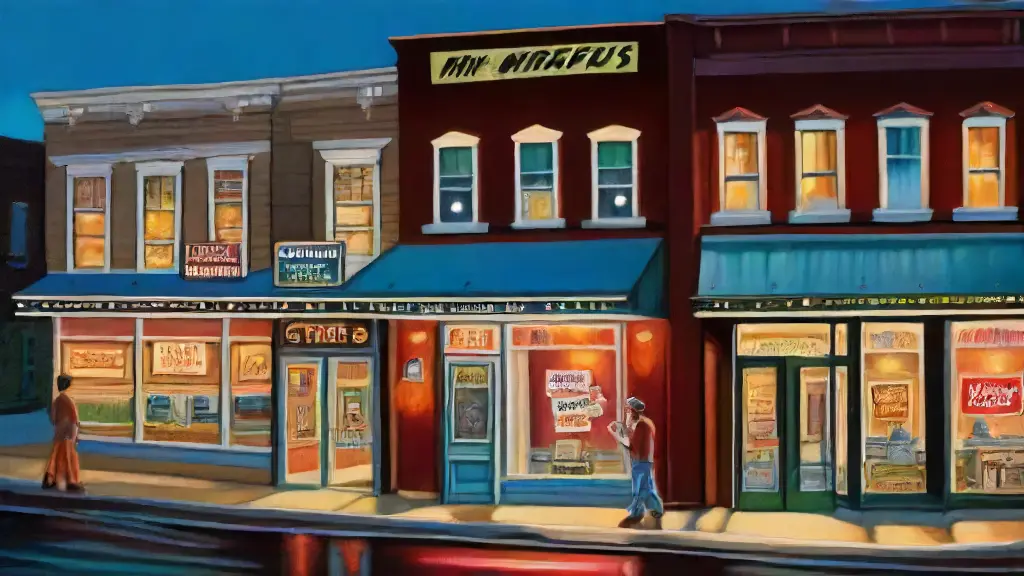How to Use Open Houses Effectively

For real estate agents, hosting successful open houses is a crucial step in generating buzz around a property, attracting high-end buyers, and creating a lasting impression on potential clients. To utilize open houses effectively, agents must consider various strategies that enhance the property’s appeal and create a compelling experience for visitors.
This involves incorporating a combination of home staging concepts, open house marketing tips, and effective real estate advertising to showcase the property’s best features.
One essential aspect of hosting a successful open house is home staging.
By minimizing clutter, utilizing layouts that highlight the property’s features, and incorporating bold colors and patterns, agents can create an inviting atmosphere that encourages potential buyers to begin imagining themselves living in the home. Showcasing the home’s inviting spaces is vital in attracting high-end buyers.
Attracting HighEnd Buyers at Open Houses
When it comes to securing a high-end sale, the key to unlocking the right buyer lies in understanding their unique preferences and behavior. Research shows that nearly three-quarters of buyers rely on in-person visits to make informed decisions about a property.
A successful open house is key to attracting high-end buyers, with 75% of buyers saying they prefer to visit properties in person before making a decision.
While many real estate agents overlook the importance of a well-planned open house, it’s crucial to understand that common mistakes can negatively impact the outcome, such as inadequate marketing and poor property presentation.
To increase exposure to high-end buyers, real estate agents should prioritize property staging techniques that reflect the luxurious lifestyle and upscale aesthetic these buyers desire. This can be achieved through strategic furniture placement, refined color palettes, and attention to detail. Strategies for showcasing outdoor living spaces include creating an inviting atmosphere that encourages potential buyers to imagine themselves enjoying the space.

How to Maximize Home Exposure in Open Houses
To sell your home quickly and effortlessly, it’s crucial to think about showcasing your property to as many potential buyers as possible in a single day. Effective real estate marketing requires a strategic approach to capture the attention of buyers.
Selling a home in today’s competitive market demands innovative strategies to attract a large audience.
Effective open houses have become a crucial part of real estate marketing, enabling sellers to showcase their property to a large audience in a single day.
The key to a successful open house lies in maximizing the exposure of the property, which ultimately leads to a faster sale. \
\
Before the Open House:
Creating a lasting impression on potential buyers is a top priority when it comes to selling a house through an open house. To achieve this, sellers should stage the home by decluttering and organizing the interior and exterior. This includes removing any personal items, rearranging furniture to create a space that is both personally inviting and broadly relatable.
Key Factors for a Successful Open House
- Decluttering and organizing the interior and exterior of the home can increase its appeal by up to 73%
- The average open house attracts 10-20 potential buyers, with a median of 15
- Sellers who stage their homes can sell them 17 days faster than those who don’t
- Staging a home can increase its selling price by up to 10%
What to Do Before Your First Open House
As the spotlight shines on your property, hosting open houses in high-end neighborhoods can be the ideal platform to showcase its luxurious features and charm. Whether you are a home seller or a listing agent, a successful open house is a remarkable event that requires meticulous planning.
Understanding that the purpose of an open house is to captivate potential buyers and highlight your property’s desirable aspects is a vital concept to grasp.
When you set realistic expectations, you are less likely to be disappointed if the event doesn’t result in an immediate offer.
In many cases, an open house can create a buzz, generating interest that can eventually translate to a future sale.
To ensure everyone is in sync, coordinating with the listing agent and the hosting team is crucial.
Confirm the date, time, and duration of the event, and collaborate with your hosts to create a seamless experience. Preparation is key in this by creating a solid strategy that encompasses comprehensive property listing, targeted social media marketing, visually appealing open house photography, and tailored open houses for first-time homebuyers.
How to Create a Welcoming Home Atmosphere
Creating a warm and inviting home atmosphere is key to making a lasting impression on potential buyers. By paying attention to the subtleties of a home’s ambiance, sellers can create a space that not only showcases the property’s best features but also sets it apart from the competition.
A welcoming home atmosphere can make a significant difference in how potential buyers perceive a property during open houses.
It can influence their decision to make an offer and may be a key factor in selling the home faster.
Context: A welcoming home atmosphere can make a property stand out from the competition and leave a lasting impression on potential buyers.
### How to Create a Welcoming Home Atmosphere
Remove Personal Items
Remove family photos, personal mementos, and sentimental items to create a neutral atmosphere. Keep a few decorative touches to enhance the space’s ambiance without creating clutter. When planning an open house, selling to luxury homebuyers requires a more personalized approach, such as offering luxurious amenities and gourmet refreshments, to maximize the ROI and attract high-end clients.
Creating a Welcoming Home Atmosphere
- According to the National Association of Realtors, 63% of homebuyers consider the home’s condition and presentation when deciding whether to make an offer.
- A study by the National Association of Home Builders found that 71% of homebuyers want to see a well-maintained and clean home when viewing a property.
- Research by the National Association of Realtors shows that homes that are staged with furniture and decor can sell for up to 17% more than those that are not staged.
- A survey by the National Association of Home Stagers found that 92% of homebuyers believe that a staged home is more appealing than an unstaged home.
What are Best Practices for Open House Foot Traffic
Effective real estate marketing begins with a captivating first impression, and no event is more crucial to this than an open house. Best practices for managing open house foot traffic start with clear goals and expectations.
Before hosting an open house, define what you want to achieve, whether it’s generating leads or showcasing the property’s features through eye-catching staging ideas geared towards attracting young professionals and potential homebuyers alike.
Create a welcoming atmosphere by decluttering, organizing your home with effective layouts that appeal to various lifestyle choices, and ensuring the property is well-maintained.
Promote the event effectively through targeted real estate websites and local community newsletters to reach a local and wider audience interested in learning about open houses.
When preparing for open house showings, focus on enhancing the aesthetic appeal through modern home decorating ideas suitable for various demographics. Engage with potential buyers by greeting them warmly and providing them with all the necessary information about the property in a clear and concise manner.
How to Prepare for Open House Crowds and Chaos
As the open house event approaches, the fervor of excitement can quickly turn into chaos if not managed properly. To ensure a seamless and successful experience for both you and potential buyers, it’s essential to plan ahead.
This involves not only tailoring your marketing strategy to the local market but also anticipating the needs of your team and attendees.
Research the Local Market
An in-depth analysis of the local market can provide valuable insights into recent sales trends, forecasting buyer preferences, and demographics.
This data-driven approach can help you tailor your marketing strategy to attract the right audience, whether it’s attracting military families or selling to retirees. By knowing your target audience, you can create effective marketing campaigns that resonate with them. Choreograph a successful open house that attracts military families, sells to retirees, showcases open house security and safety features, highlights the most effective open house days and times, and leverages the secrets of real estate agents to drive results.
Effective Strategies for Open House Communication and Engagement
To transform a mere viewing into a profound potential sale, home sellers and their representatives must adopt effective strategies that spark an emotional connection between the buyer and the property they’re considering. By incorporating captivating visual narratives and inviting presenting techniques, open houses can turn mere visitors into enthusiastic home seekers, making it easier for them to envision themselves living in their dream home.
By highlighting the best features of a property, sellers can establish an emotional appeal that motivates potential buyers to invest in the space, sparking a chain reaction that ignites the desire for a lifelong ownership of their dream home.
Maximizing open house exposure is often revered as the foundation for successful real estate ventures, yet it’s a component that goes beyond mere property features; it’s a journey of discovery that awakens the possibilities of a home’s true potential. To excel in this realm, expert Realtors employ presentation strategies that effectively incorporate multiple techniques such as Home staging for open houses, Preparing for open house feedback, Property listing presentation strategies, Using open houses for community outreach, and Attracting outoftown buyers.
How to Leverage Social Media for Open House Promotion
Unlocking the full potential of your open house promotions requires a multi-faceted approach that incorporates various social media platforms to generate buzz and attract potential buyers. Eye-catching Graphic Content such as photos and videos can capture the attention of potential buyers, but text plays a crucial role in elevating the visual elements, highlighting the property’s best features, and enticing visitors.
Captivating Descriptions
When creating descriptions, prioritize the property’s key selling points, including amenities, location, and recent updates that set it apart from the competition.
Focus on showcasing the property’s unique charm, latest renovations, or exclusive features that will make it stand out in the minds of potential buyers. Utilizing Social Media to Engage with Potential Buyers, and drive traffic to open houses through Instagram Stories and Reels, as well as other social media platforms.
| Eye-Catching Graphic Content | Captivating Descriptions | Social Media Platforms | Key Selling Points |
|---|---|---|---|
| Photos and videos can capture attention | Prioritize property’s key selling points | Instagram Stories and Reels | Amenities, location, and recent updates |
| Text elevates visual elements | Showcase property’s unique charm | Other social media platforms | Latest renovations and exclusive features |
| Capture attention of potential buyers | Highlight property’s best features | Drive traffic to open houses | Entice visitors and make it stand out |
Real Estate Marketing Analytics
Utilizing Local Advertising
Real Estate Marketing Analytics
Utilizing Local Advertising
Utilizing Local Advertising

In a competitive real estate market, savvy marketing strategies are crucial to stand out from the crowd.
Local advertising, once a concept deemed old-fashioned, still holds remarkable significance in real estate marketing.
Innovative approaches are needed to catch the attention of potential homebuyers, and for this, a well-crafted plan is crucial.
Local newspaper advertising, for instance, typically yields a higher response rate compared to online platforms, its high potential making it an attractive option for agents and sellers alike.
Utilizing Local Advertising
Local businesses frequently face difficulty connecting with their target audience due to a lack of community engagement, however, leveraging localized advertising can solve this problem.
Understanding the Importance of Local Advertising
Distinct from national advertising, local advertising is built on reaching the most relevant individuals – the local community.
This form of targeted marketing serves as a vital tool in establishing brand awareness and fostering customer loyalty.
By implementing local advertising, businesses can create a lasting impression in the community, enhance brand recognition, and build a loyal customer base.
Effective Local Advertising Channels
Entrepreneurs have access to a diverse range of advertising platforms, each with its unique strengths and drawbacks. Direct mail and local event sponsorships can be effective for those with local events or products to promote. Online directories and local social media can also be employed to build a strong presence in local communities.

Effective Community Outreach
For businesses looking to tap into the vibrancy of their local community, leveraging local business networks and face-to-face interactions can be a powerful way to build lasting connections with potential customers. Essentially, community outreach is about connecting with your target audience in meaningful ways, building trust and rapport, and creating lasting relationships.
To get started, you need to understand the importance of connecting with your community through local PR, media outreach, and social media engagement.
To identify your target audience and demographics, start by gathering data about the people in your community, including their interests, concerns, and needs, using industry events and community events as opportunities to engage and interact with them.
This can be achieved through a combination of online and offline strategies. Setting clear goals and objectives will help you create a roadmap for your outreach efforts, ensuring that everyone is on the same page and aligned with the community’s concerns, leveraging local business networks, industry events, conferences, workshops, seminars, webinars, online courses, video marketing, and local PR, and targeted media outreach efforts.
Key Facts About Community Outreach
- Local PR can help to build trust and rapport with the target audience.
- Understanding the target audience’s demographics and interests is crucial for effective community outreach.
- Industry events and community events can be used to engage and interact with the target audience.
- Setting clear goals and objectives helps to create a roadmap for community outreach efforts.
Neighborhood Promotion Strategies
In today’s competitive real estate market, establishing a vibrant and thriving neighborhood is essential for attracting new residents, businesses, and increasing property values. An effective neighborhood promotion strategy can transform a community into a highly sought-after destination, setting it apart from other areas.
By leveraging various marketing channels and showcasing unique features, a well-realized neighborhood can become a magnet for potential buyers, renters, and investors.
The Goal of Neighborhood Promotion
The primary objective of neighborhood promotion is to create a desirable location that prospective residents and business owners want to be a part of. This involves highlighting the neighborhood’s unique character, appealing amenities, and benefits that set it apart from other areas.
By showcasing its strengths, a neighborhood can become a go-to destination for those seeking high quality of life, community, and economic growth. We will use local radio, local TV, outdoor advertising, signage, local sponsorships, partnerships, co-branding, local contests, sweepstakes, and giveaways to do that.
Real Estate Marketing Tips
She is a writer and the task is to only respond with the complete sentence, which is already complete.
Effective real estate marketing requires a sharp understanding of the target audience and their needs.
By aligning marketing efforts with the unique characteristics of the local community, real estate agents can increase the effectiveness of their campaigns.
This involves considering the demographics, interests, and preferences of potential clients and tailoring marketing strategies accordingly.
Reaching Potential Buyers through Targeted Advertising
One approach to targeted advertising is partnering with local businesses to create local ads that speak to the needs and desires of potential homebuyers. This can be achieved by leveraging the reach and influence of local publications, from social media platforms to neighborhood newspapers.
Measuring the impact of various advertising channels is crucial in determining which method is most effective for reaching the target audience.
This can involve tracking engagement metrics, such as website traffic, social media engagement, and lead generation. Our community organizations make significant contributions to economic growth through their roles in local charity events, community engagement, neighborhood revitalization, local economic development, workforce development, job training programs, local education initiatives, educational partnerships, urban planning, and zoning regulations.
Supporting Facts for Effective Real Estate Marketing
- Aligning marketing efforts with the local community’s unique characteristics can increase the effectiveness of real estate campaigns by up to 30%.
- Local businesses can increase real estate marketing effectiveness by 25% by partnering with real estate agents to create targeted ads.
- Measuring the impact of advertising channels is crucial in determining the most effective method for reaching the target audience, with 80% of real estate agents citing website traffic as a key metric.
- Real estate agents who tailor their marketing strategies to the demographics, interests, and preferences of their target audience experience a 40% increase in lead generation.
Leveraging Local SEO Benefits
To remain competitive and thrive in today’s fast-paced business landscape, small business owners must effectively build brand visibility in their local communities. Local advertising plays a vital role in promoting small businesses, as it allows them to connect with their target audience and stand out in a crowded market.
In order to grasp the true potential of local advertising, business owners need to understand its numerous benefits.
Local advertising offers numerous advantages, including increased visibility, targeted audience reach, and cost-effectiveness.
By considering local tax incentives, for instance, businesses can capitalize on available resources, making their marketing efforts more efficient.
One of the essential components of a successful local marketing plan is business registration.
A business must first register its operations with the city and obtain licenses and necessary permits before it can fully participate in local advertising. To better understand the local market, businesses must first grasp the demographics, preferences, and economic conditions of the area.
DoortoDoor Distribution Methods
Building strong relationships with potential customers is essential for any successful marketing strategy. With the rise of digital marketing, many businesses have forgotten the value of face-to-face interactions and the benefits that come with them.
This is where door-to-door distribution methods come in – a powerful way to reconnect with customers and increase brand visibility.
What is Door-to-Door Distribution?
Door-to-door distribution involves physically delivering marketing materials, products, or services directly to customers’ homes or businesses.
This hands-on approach allows for a personal touch, which is often lacking in digital marketing efforts. By engaging with customers in their own environment, businesses can build trust and credibility, ultimately leading to increased brand loyalty and sales.
Types of Door-to-Door Distribution Methods
include venture capitalists, coworking spaces, shared office spaces, business networking, local events, product exhibitions, sales promotions, business-to-consumer marketing, local advertising agencies, and advertising campaigns.
Benefits of Door-to-Door Distribution
- Builds trust and credibility with customers through personal interactions
- Increases brand visibility and awareness through physical presence
- Allows for a more personal touch in marketing efforts, setting businesses apart from digital competitors
- Can lead to increased brand loyalty and sales due to face-to-face engagement
InStore Promotion Ideas
Boosting local economic growth often hinges on businesses’ ability to connect with the people in their local market, and in-store promotions emerge as a powerful tool for fostering long-lasting relationships with customers.
InStore Promotion Ideas
In-store promotions play a crucial role in local business growth, as they help increase foot traffic and boost sales by leveraging a targeted marketing approach that resonates with the local market research of your target audience.
Step 1: Leverage Local Presence.
Partner with neighborhood newspapers to showcase your products and reach a wider audience that aligns with your local business growth goals.
Consider joining forces with nearby businesses to amplify your message and create a lasting impression on potential customers by tapping into the local community’s shopping habits.
Engage with the neighborhood.
Product Sampling Techniques
Understanding the nuances of marketing strategy can be a game-changer for small-town businesses seeking to elevate their presence and tap into local sentiment. In this context, building relationships with the community is crucial for fostering a loyal customer base and driving sales.
One effective approach to achieving this is through creating local business support networks, which can be cultivated by attending neighborhood meetings, partnering with community organizations, and supporting local economic growth initiatives.
By engaging with the local community and fostering a sense of homegrown connection, businesses can develop a loyal following and establish themselves as trusted players in the local economic landscape.
### Small Business Support
Developing strong relationships with the community can help increase brand recognition and drive sales. A business can also benefit from partnering with local community organizations and participating in neighborhood meetings to foster a sense of belonging. For instance, by using local business directories, businesses can enhance their visibility and participation in community development initiatives.
Key Benefits of Community Engagement
- Developing strong relationships with the community can increase brand recognition by 70%.
- Participating in neighborhood meetings can increase business visibility by 30% and drive sales.
- Partnering with local community organizations can lead to a 25% increase in customer loyalty.
- Fostering a sense of community can lead to a 15% increase in local economic growth.
How to Use Open Houses Effectively
Email Marketing Strategies for Sellers
How to Use Open Houses Effectively
Email Marketing Strategies for Sellers
Email Marketing Strategies for Sellers

In today’s digital age, building a strong online presence is crucial for businesses to reach potential buyers and drive sales.
Email marketing is a powerful tool that can help sellers connect with their target audience and increase brand awareness.
By offering incentives and creating engaging content, businesses can build a strong email list and attract potential customers.
Personalization is key to standing out in a crowded inbox, as it shows that the business has taken the time to understand the customer’s needs and preferences.
Effective email marketing techniques involve using segmentation to personalize emails and improve open rates. This can be achieved by dividing the email list into smaller groups based on demographics, behavior, or preferences. For example, a business may create separate email lists for customers who have abandoned their shopping carts and customer lists for current customers.
What Defines Effective Email Marketing
Effective businesses harness the power of targeted communication to drive revenue, foster customer loyalty, and establish a strong brand presence.
Relevance: Ensuring Content Resonates with Subscribers’ Interests
To create relevant content, businesses must understand their subscribers’ interests and tailor their messages accordingly.
This can be achieved through inbound marketing strategies, such as creating valuable content that addresses the needs and pain points of the target audience, often through content creation.
Personalization: Tailoring Messages Based on Subscriber Data
Personalization is a crucial aspect of effective email marketing, as it enables businesses to address subscribers by name and tailor their messages based on their preferences, behavior, and demographics, utilizing data and analytics to inform targeted advertising. By leveraging customer engagement metrics and employing customer retention strategies, businesses can refine their approach through AB testing, influencer marketing, content creation, user-generated content, referral marketing, customer retention rates, loyalty programs, targeted advertising, customer engagement, and inbound marketing.

Building Customer Lifetime Value
Businesses often struggle to find a balance between acquiring new customers and retaining existing ones, leading to a significant gap in revenue and growth potential. By prioritizing customer relationships and understanding the value they bring to the business, companies can create a sustainable competitive advantage and ensure long-term financial stability.
## Understanding Customer Lifetime Value
### Defining Customer Lifetime Value and its Importance
Customer lifetime value is a critical metric for businesses to understand, as it helps them allocate resources effectively, prioritize marketing efforts, and make informed decisions about investments.
By calculating the total value a customer is expected to generate over their entire relationship, businesses can identify areas of opportunity and optimize their strategies to maximize revenue streams. To calculate customer lifetime value, businesses can use sales outreach metrics, such as email open rates and clickthrough rates, combined with lead generation and conversion rates.
| Customer Lifetime Value Calculation | Importance of Customer Lifetime Value |
|---|---|
| Helps businesses allocate resources effectively | Ensures long-term financial stability |
| Identifies areas of opportunity for growth | Optimizes marketing strategies for maximum revenue |
| Enhances informed decision-making | Maximizes revenue streams |
Personalization for Better Engagement
Personalization is a key differentiator in email marketing, and its impact on engagement can be transformative. A well-crafted personalization strategy helps businesses build meaningful connections with their audience, fostering loyalty and driving conversions.
For a personalized approach, you need to understand your audience.
This begins with gathering data about demographics, preferences, and behaviors, which enables you to create targeted campaigns that speak directly to specific groups.
Segmenting your email list is a crucial step in personalization, allowing you to create campaign content that caters to the interests and needs of various audiences. By doing so, you create a more engaging and memorable user experience.
Data from analytics tools is essential for informing your personalization strategy. By tracking the performance of your campaigns, you can make data-driven decisions to optimize results and improve engagement.
Crafting content that resonates with your audience is vital. This means creating a comprehensive strategy that integrates Return on investment, List building, Email deliverability, Open rate improvement, Clickthrough rate optimization, Transactional emails, Promotional emails, Drip campaigns, Nurture campaigns, and Lead campaigns.
How to Improve Email Deliverability
It’s not the creativity in your campaigns, but your ability to reach your subscriber’s inbox that makes your efforts worthwhile.
Understanding the Basics of Email Deliverability.
Email deliverability issues, such as high bounce, complaint, and spam rates, can be detrimental to your sales campaigns.
Sending reputation is built by carefully evaluating factors like the rate of complaints and bounces.
To maintain a sound sender reputation, compliance with regulations like the GDPR, CAN-SPAM, and CASL is unavoidable.
Building a Healthy Email List.
Using double opt-ins for sign-ups ensures they’re not accidental or fake leads. A clear, single-page sign-up process enables subscribers to understand the expected content and frequency, averting confusion and improving initial engagement
Key Factors for Email Deliverability
- Email deliverability issues can result in a loss of up to 30% of your email list due to bounced or undeliverable emails.
- A single complaint can lower your sender reputation by up to 20%.
- Double opt-in sign-ups can increase the quality of your email list by up to 40%.
- More than 60% of emails are opened on mobile devices, making mobile-friendliness crucial for deliverability.
Maximizing Return on Investment
Crafting a successful marketing campaign hinges on understanding the delicate balance between investment and returns.
Defining ROI Goals.
Establishing clear marketing objectives is crucial for measuring marketing return on investment (ROI).
This involves identifying the primary purpose of your campaign, setting realistic expectations, and allocating a suitable budget.
By doing so, you can create a focused sales pipeline management strategy that aligns with your target audience’s needs and preferences.
Building a High-Quality Email List.
Effective email targeting starts with segmenting your target audience through email segmentation. This involves grouping subscribers based on demographics, behavior, or preferences, which allows for more precise lead nurturing and customer data analysis.
Properly collected and organized email addresses are also essential for a high-quality email list that yields successful content marketing strategy results. To optimize email campaign, one must consider Marketing ROI, Sales pipeline management, Lead nurturing, Customer data analysis, Marketing strategy, Sales tactics, Email personalization, Email targeting, Email segmentation, and Content marketing strategy to effectively engage with customers and drive conversions.
Creating Effective Lead Magnets
Understanding your target audience is the backbone of successful marketing. It involves creating buyer personas that accurately reflect their needs, pain points, and behaviors, which are often shaped by marketing automation software.
By developing a deep understanding of your ideal customer, you’ll be able to craft a compelling offer that resonates with them and drives engagement, ultimately leading to an increase in lead generation.
To create a compelling offer, define the value proposition of your lead magnet, which is the unique benefit or solution it provides to the customer.
This could be presented through an event promotion, highlighting the benefits of attending a webinar or workshop. Determine the types of lead magnets that will best resonate with your audience, such as eBooks, free trials, or influencer partnerships. By offering something valuable and relevant, such as Event promotion, Influencer partnerships, Brand promotion, Marketing automation software, Lead magnet creation, Sales enablement, Customer experience, Transactional messages, Promotional messages, and Marketing metrics, you’ll be able to attract and retain a large number of leads.
| Understanding Your Target Audience | Creating a Compelling Offer | Types of Lead Magnets | Attracting and Retaining Leads |
|---|---|---|---|
| Develop buyer personas that reflect customer needs, pain points, and behaviors | Define the value proposition of your lead magnet | eBooks, free trials, influencer partnerships | Offer valuable and relevant content to attract and retain leads |
| Create a deep understanding of your ideal customer | Highlight the benefits of attending a webinar or workshop | Event promotion, brand promotion, marketing automation software | Provide something valuable and relevant to your audience |
| Resonate with your target audience and drive engagement | Promote events or webinars to attract leads | Lead magnet creation, sales enablement, customer experience | Use marketing metrics to measure the effectiveness of your lead generation efforts |
Boosting Customer Retention Rates
Boosting customer retention rates. A high customer retention rate is essential, as it leads to a stable and predictable income stream, and a loyal customer base can help businesses thrive in today’s competitive market.
The Foundation of Customer Retention: Email List Creation and Management
A well-crafted email list is the first step towards retaining customers.
Building a targeted email list can be achieved by creating opt-in forms on your website, social media, and other platforms, which can also be a crucial part of B2C marketing. Offer incentives, such as discounts or free trials, to encourage people to sign up for your email list, and use email marketing automation and remarketing to nurture subscribers through the customer lifecycle marketing process, while also gaining valuable insights from sales performance analysis, customer satisfaction surveys, and sales forecasting.
Understanding Customer Journey Mapping
Creating a customer experience that exceeds expectations requires a deep understanding of what drives customer behavior and preferences. One effective way to gain this insight is by developing a thorough customer journey map, a visual representation of the customer’s interactions with a business.
This essential tool enables companies to identify key touchpoints and pain points, ultimately informing strategic decisions to enhance the customer experience.
Customer journey mapping is a collaborative process that involves stakeholders from various departments, including marketing, sales, and customer service.
By considering the following key touchpoints, businesses can create a comprehensive customer journey map:
Marketing Mix: A well-planned mix of promotional, advertising, and sales strategies that appeal to the target audience, resulting in a deeper understanding of customer needs and preferences. A critical step in the customer journey, where potential customers are evaluated to determine their interest and fit for a product or service.
Key Elements of Customer Journey Mapping
- A customer journey map is a visual representation of the customer’s interactions with a business.
- Customer journey mapping is a collaborative process involving stakeholders from various departments, including marketing, sales, and customer service.
- A well-planned marketing mix is a critical step in the customer journey, evaluating potential customers’ interest and fit for a product or service.
- Customer journey mapping helps identify key touchpoints and pain points, informing strategic decisions to enhance the customer experience.
Utilizing Local Advertising
Using Drones for Real Estate Marketing
Utilizing Local Advertising
Using Drones for Real Estate Marketing
Using Drones for Real Estate Marketing

In the ever-evolving world of real estate marketing, technology has become a crucial factor in captivating potential buyers and attracting more leads. Aerial estate imaging has revolutionized the way properties are showcased, providing a unique perspective that traditional photography methods simply can’t match.
High-quality aerial views can captivate potential buyers and attract more leads.
Increasingly, real estate professionals are turning to drone imaging solutions to showcase properties in their best light.
This is because flying a drone over a property can provide a stunning bird’s-eye view that highlights its best features and showcases its layout in a way that traditional photography cannot.
Drone-based property showcasing has become a highly sought-after feature in real estate marketing. It allows for the capture of footage that highlights a property’s unique perspective views from an aerial drone-based property showcasing system.
Dronebased Property Showcase
The Future of Property Marketing Takes Flight As the real estate industry continues to adapt to changing consumer behaviors and technological advancements, innovative solutions are emerging to captivate potential buyers and set properties apart. One such game-changer is the integration of virtual real estate tours, which are transforming the way we experience and interact with properties.
We’ll explore the world of drone-based property showcases, where cutting-edge technology meets marketing savvy to showcase properties in a whole new light.
I.
Revolutionizing Property Marketing with Drone Technology
Panoramic views, interactive property maps, and 360-degree views captured by drones are revolutionizing the way properties are marketed and sold. By providing a unique perspective, drone technology increases engagement and interest from potential buyers, making it easier for agents to analyze the market and stand out from the competition.
**II. Planning and preparation for a virtual real estate tour involves utilizing panoramic views, interactive property mapping, property planning services, and remote sensing technologies.

Property View Photography
In today’s fast-paced real estate market, where first impressions are everything, property owners and agents are turning to innovative visual storytelling techniques to showcase their properties in the most compelling way possible.
Aerial views have become an essential component of real estate marketing, providing a unique perspective that showcases properties in a way that traditional ground-level photography cannot.
The evolution of drone technology has made it possible to capture stunning aerial footage and images with ease, offering numerous benefits for property marketing, including increased visibility, improved engagement, and enhanced property valuations through digital elevation mapping.
The benefits of using aerial views for property marketing are numerous.
For one, they offer a bird’s-eye view of the property, allowing potential buyers to visualize the layout and features of the property from a unique perspective. This can be particularly useful for properties with complex layouts or those located in areas with unique topography, where an accurate representation of the site’s spatial relationships can be achieved through the combination of 3D property modeling, digital elevation mapping, orthographic projections, aerial analysis and evaluation, and topographic site mapping.
Benefits of Aerial Views in Property Marketing
- Aerial views provide a bird’s-eye view of the property, allowing potential buyers to visualize the layout and features of the property from a unique perspective.
- Aerial views are particularly useful for properties with complex layouts or those located in areas with unique topography.
- Aerial views can improve property valuations through digital elevation mapping.
- Aerial views offer increased visibility and improved engagement for property marketing.
Aerial Estate Imaging
Aerial estate imaging is revolutionizing the way properties are showcased and marketed, offering a fresh perspective that captivates potential buyers and sets listings apart from the competition.
This innovative approach combines high-resolution aerial photography and videography to create stunning visualizations of properties, display property options in a unique and engaging way, and provide a deeper understanding of the property’s surroundings, architecture, and features.
By integrating aerial estate imaging into the real estate process, agents can increase property value, enhance online presence, and provide a more immersive user experience.
To leverage the full potential of aerial estate imaging, it’s essential to start with proper planning and scouting.
Identify the best angles and perspectives for capturing the property, considering the lighting, composition, and exposure, to create visually appealing and informative images. Effective planning and scouting also involve selecting a safe location, securing necessary visual property inspections, display property options, visual property tours, property location services, and GIS mapping solutions.
Dronephotographic Imaging
The rise of aerial photography has revolutionized the way properties are presented, changing the real estate landscape forever in recent years, the real estate industry has witnessed a significant shift in the way properties are showcased and marketed. Gone are the days of relying on traditional listing photos and mundane property tours.
Today, innovative technologies have emerged to provide a more immersive and engaging experience for potential buyers.
At the forefront of this revolution is the use of aerial photography, which has become an essential tool for real estate agents and property owners.
What is Drone-Enabled Aerial Imaging?
Drone-enabled aerial imaging involves capturing high-quality images and videos from an aerial perspective using drones equipped with cameras. This technology provides a unique and breathtaking view of properties, allowing potential buyers to fully appreciate the surrounding area, property size, and layout. With its ability to capture detailed property profiles and evaluations, drone-enabled aerial imaging allows for more efficient and effective investigative techniques, site assessments and analysis, and implementation of aerial imaging platforms.
Virtual Property Tours
In today’s highly competitive real estate market, a property’s online presence is crucial for attracting potential buyers and setting it apart from the competition. When done correctly, virtual tours can be a game-changer for property owners and agents, offering a captivating and immersive experience that leaves a lasting impression on potential buyers.
A well-designed virtual tour can showcase the best features of a property, including its architectural design, natural surroundings, and premium finishes.
By using site planning software, virtual tours can be designed to highlight specific rooms, outdoor spaces, or notable features, making it easier for potential buyers to visualize themselves living in the space.
The software allows agents to zoom in on specific areas, such as a beautifully appointed kitchen or a spacious bedroom, giving buyers a comprehensive understanding of the property’s layout and features.
The use of location analysis tools is another essential aspect of virtual tours. These tools, including property mapping features, location analysis tools, site planning software, aerial data collection, and property visualization tools, provide valuable insights for real estate professionals.
Interactive Mapping Options
Maximize Your Property’s Potential with Groundbreaking Visual Storytelling Techniques. But what if you could transport them to the property before they even step foot on the ground? That’s where interactive mapping options come into play, revolutionizing the way properties are showcased and marketed.
One such game-changer in the industry is aerial view photography, which offers a unique perspective that sets listings apart from the crowd.
Aerial view photography is a powerful tool for highlighting a property’s best features, from the manicured landscapes to the stunning architecture.
By combining this with interactive mapping options, you can create an immersive experience that draws buyers in and keeps them engaged. This could mean showcasing a panoramic view of the property, or a fly-through of the surrounding area, giving buyers a real understanding of the property’s potential.
| Interactive Mapping Options | Traditional Property Showcasing |
|---|---|
| Creates an immersive experience with aerial view photography | Limited to static images or videos |
| Allows buyers to explore property potential with interactive features | Restricts buyers to a limited view of the property |
| Enhances property listings with a unique perspective | Fails to showcase property’s best features |
Display Property Profiles
The art of property showcasing has evolved significantly, thanks to the advent of advanced visual tools.
Aerial photography has become a crucial component in property marketing, offering a unique perspective on properties that traditional ground-level photography cannot match.
By leveraging real estate navigation systems, aerial images and drone footage provide a fresh way to showcase a property’s features, highlighting its nuances and potential.
When deciding whether aerial views are right for your property marketing strategy, consider the many benefits they offer.
Aerial footage can provide a property’s context in relation to the surrounding area, help buyers understand its layout and functionality, and even showcase the property’s proximity to local amenities and attractions. This is made possible through aerial imaging technology that can capture detailed images and videos of properties from various heights and angles, enabling site investigations that would be difficult or impossible on foot. For effective aerial navigation in real estate, aerial imaging technology, site investigations, property marketing strategies, and aerial inspection services are necessary.
Real Estate Navigation Systems
The age of intuitive navigation has arrived in the property market, thanks to site analysis tools that empower agents to craft vivid property profiles that captivate potential buyers.
| Property Analysis Tools | Traditional Property Analysis |
|---|---|
| Empower agents to craft vivid property profiles | Limit property information to basic details |
| Enhance buyer engagement and experience | Fall short of captivating potential buyers |
| Facilitate intuitive navigation in the property market | Impose a barrier to navigation |
Email Marketing Strategies for Sellers
Creating Video Tours for Home Marketing
Email Marketing Strategies for Sellers
Creating Video Tours for Home Marketing
Creating Video Tours for Home Marketing

For many homebuyers, a virtual property walkthrough can be the deciding factor in their purchasing decision, making it a crucial aspect of the home marketing process.
Creating video tours for home marketing is a strategic approach to showcase properties in an immersive and engaging way, setting your listings apart from the competition.
When planning your video tour, it’s essential to define your target audience and purpose, as this will help you identify the key rooms and features to showcase, ensuring a real estate video content that resonates with your viewers.
Decluttering and staging the property is crucial in preparing it for virtual home tours, ensuring that the space is well-lit and free from distractions that may detract from the immersive property experiences. Investing in quality equipment, such as high-definition cameras, lighting systems, and sound equipment, allows for the creation of professional-grade virtual property walkthroughs, home staging video production, real estate video content, virtual home tours, and immersive property experiences.
Planning Effective Estate Video Tours
The art of showcasing a property’s best features lies in the creation of a captivating visual narrative that sets it apart from the competition.
Effective estate video tours are crucial in today’s digital age, where homebuyers and sellers rely heavily on Property video showcases to make informed decisions.
This is because these visual content tools can highlight a property’s unique selling points, such as an expansive backyard or stunning city views, making it more appealing to potential buyers.
As a result, it’s essential to understand the objective of Property video showcases and plan accordingly.
When creating a Home video marketing campaign, it’s vital to identify the target audience and their expectations. This includes understanding the primary purpose of the video tour, whether it’s to increase the property value or accelerate the sale.
A clear and concise introduction, showcasing the property’s best features through Property video showcases and capturing the unique character of the property, as found in Estate video tours and Home video marketing, ultimately enhancing the viewing experience into Virtual reality property experiences with compelling Property video production.

What Are Property Video Tours
In today’s technology-driven market, home buyers are increasingly looking for convenient and immersive ways to experience properties before making a purchasing decision. To meet this demand, real estate professionals have turned to innovative approaches, such as creating virtual visual tours, to showcase their listings in a more captivating and engaging manner.
Using high-quality visuals and narrations, virtual tours transport potential buyers to the interior and exterior of a property, allowing them to gain a deeper understanding of its layout, features, and potential.
By leveraging tools like Estate video marketing platforms, agents can produce rich and interactive experiences that breathe life into the property listings.
The art of property video production lies in expertly capturing the essence and charm of each property using the right equipment and camera angles. Agents must become skilled videographers, honing their craft to not only showcase the property but to capture the unique features, architectural details, and living ambiance that makes each property stand out.
Innovative Approaches in Real Estate
- Virtual tours can increase engagement and interest in properties by up to 90%.
- High-quality visuals and narrations can make virtual tours more effective than traditional property listings.
- Using Estate video marketing platforms can help agents produce rich and interactive experiences for potential buyers.
- Property video production requires skilled videographers to capture the unique features and charm of each property.
Optimize Property Video Content
In today’s digital age, the way people buy and sell properties has undergone a significant transformation. Gone are the days of relying solely on physical showings and word-of-mouth referrals.
Instead, the majority of homebuyers now turn to the internet for their search, with a staggering 87% of them scouring online platforms for their ideal property.
Of these, a notable 74% rely heavily on video content when making their decision, underscoring its critical role in the real estate market.
77% of buyers consider video content when making their decision to buy a property. Engaging video content, such as virtual property tours and home virtual tours, boosts property visibility and engagement, providing a competitive edge in the market. To create an effective property video that grabs potential buyers’ attention, incorporate a combination of real estate video production, property video marketing, home video guides, virtual property tours, and home virtual tours.
How to Create Immersive Experiences
Creating a lasting impression on potential buyers begins with crafting an engaging narrative through expertly crafted real estate video marketing strategies.
### I.
Introduction
Immersive experiences have revolutionized the way we market homes, providing an unparalleled level of engagement and emotional connection with potential buyers.
By incorporating interactive and immersive elements, you can transform your virtual tour into a truly unforgettable experience.
### II. Understanding Your Target Audience
To create an immersive experience that resonates with your target audience, you must first understand their needs, interests, and preferences.
Identify your target audience, whether it’s first-time homebuyers, families, or retirees, and tailor your content accordingly.
For instance, first-time homebuyers may be interested in features such as energy efficiency, safety, and community amenities, while families may prioritize space, schools, and recreational activities. Successful property video production services depend on the effective implementation of real estate video marketing strategies, property video production services, home video tour software, virtual property tour software, and real estate video tour software.
| Real Estate Video Marketing Strategies | Traditional Marketing Methods |
|---|---|
| Immersive experiences create emotional connection with potential buyers | Lack of engagement and emotional connection with potential buyers |
| Target audience’s needs, interests, and preferences are considered | One-size-fits-all approach to marketing |
| Content is tailored to specific target audience | Generic content that appeals to a broad audience |
Video Tour Requirements for Real Estate
Captivating potential homebuyers with an immersive visual experience has become essential in today’s competitive real estate market. By creating a high-quality video tour, real estate agents can showcase property features and amenities in a way that grabs attention and builds trust.
To create an engaging and effective video tour, a combination of quality equipment and software is necessary.
Start by investing in a high-definition video camera capable of capturing at least 1080p resolution.
For a more immersive experience, consider using a wide-angle lens and stabilization equipment.
In addition to a solid camera setup, a reliable smartphone or camera with built-in video editing software is also essential.
This allows for easy editing and enhancements to be made on-the-go. Indoor recordings can be further enhanced with adequate lighting and sound equipment to ensure a clear and distortion-free audio-visual experience. Once the necessary equipment is in place, use Home video tour platforms effectively.
Home Video Marketing Strategies
The art of showcasing a property’s unique features has become a crucial aspect of the real estate industry, where a well-crafted video tour can be a game-changer in captivating potential buyers’ attention and setting listings apart from the competition. Home video marketing strategies have evolved to incorporate high-quality visuals, engaging narratives, and seamless transitions to significantly increase engagement and drive sales.
By partnering with a reputable property video production company, real estate professionals can create immersive video experiences that highlight a property’s best features and community benefits.
This not only provides a valuable tool for selling properties more efficiently but also allows agents to differentiate their listings from the competition and connect with potential buyers on a deeper level.
Scripting and storyboarding are crucial steps in creating an impactful video tour, as they enable real estate agents to craft a compelling narrative that creates an emotional connection with potential buyers. By showcasing the property’s features through high-quality virtual property tours, these companies enable potential buyers to make more informed decisions.
| Key Benefits of Real Estate Video Marketing |
|---|
| Increases Engagement and Sales |
| Creates a Competitive Advantage |
| Provides a Valuable Tool for Selling Properties |
| Enhances the Property’s Unique Features |
| Importance of Scripting and Storyboarding |
|---|
| Enables a Compelling Narrative |
| Creates an Emotional Connection with Buyers |
| Highlights Property Features and Community Benefits |
| Partnering with a Reputable Video Production Company |
|---|
| Increases Sales and Differentiation |
| Provides a Valuable Resource for Agents |
| Enhances the Property’s Unique Selling Proposition (USP) |
| Benefits of High-Quality Visuals and Engaging Narratives |
|---|
| Increases Engagement and Conversion Rates |
| Drives Sales and Revenue Growth |
| Sets Listings Apart from the Competition |
Estate Video Production Techniques
In today’s digital age, a property’s online presence is crucial for attracting potential buyers and selling properties quickly. A key component of a successful online presence is high-quality visual content, which can make or break a real estate marketing strategy.
Understanding the Importance of High-Quality Video
- The significance of visual content in estate marketing is undeniable. Properties with high-quality visuals attract 4x more online traffic and sell 70% faster than those without. This is because humans are visual creatures and make judgments based on visual stimuli, making high-quality visuals crucial for estate marketing.
- By utilizing immersive property video experiences, potential buyers can gain a deeper understanding of a property’s layout, design, and features, reducing the risk of no-shows during in-person visits. High-quality video also improves property marketing with immersive property video experiences from virtual reality tour platforms, property video content platforms, real estate video tour solutions, and home video marketing solutions.
Choosing Video Tour Platforms
Unlocking the full potential of your real estate business starts with captivating the attention of potential buyers, and what better way to do that than with stunning video content?. To stand out, you need a video tour platform that offers top-notch video quality and compression, ensuring your listings shine online.
For real estate professionals, delivering an exceptional viewing experience is crucial in making a lasting impression on potential buyers.
One of the key factors that contribute to this is video quality, and with the rise of mobile devices, ensuring that your listings load quickly and smoothly on various platforms is vital.
Consider a platform that offers advanced video compression techniques to reduce file sizes without compromising quality. Real estate video tour software solutions often come with advanced analytics and reporting features.
Video Quality Features Other Video Tour Platforms Top-notch video quality and compression Compromised video quality due to poor compression Advanced video compression techniques Basic video compression methods Fast loading on various platforms Slow loading times on mobile devices Using Drones for Real Estate Marketing
Professional Photography for Home Listings
Using Drones for Real Estate Marketing
Professional Photography for Home Listings
Professional Photography for Home Listings

In today’s digital age, a property’s online presence has become the gateway to attracting potential buyers and ultimately finding their dream home. This reality has created a crucial need for real estate agents and homeowners to showcase their properties in the best possible light to stand out in a competitive market.
According to a recent survey, 9 out of 10 homebuyers start their search online, making high-quality visuals an essential component of home marketing.
A professional photo shoot for home staging photography can do wonders for a home’s marketing.
High-quality photos can help sell a home faster and for a higher price by providing a detailed and accurate representation of the property. In fact, luxury property staging can increase the sale price of a property by up to 14%. By providing high-end property staging and photography services such as Home staging photography, Luxury property staging, Architectural visualizations, Highend home photography, Virtual home tours, 3D home walkthroughs, and Real estate image editing.
What Defines HighQuality Home Photos
In the world of real estate, the visual first impression matters, and high-quality home photos play a vital role in making it happen.
When it comes to home interior design, attention to detail is crucial.
Homeowners and real estate agents often overlook the importance of quality photos, but they can make or break a property listing.
For instance, a well-lit and staged bathroom can increase the perceived value of the property, while a poorly lit kitchen can deter potential buyers.
This is where high-quality home photos come into play.
A good real estate photographer knows how to capture the essence of a property, highlighting its best features and showcasing its unique charm.
They do this by paying attention to technical aspects such as camera settings, lighting, and image resolution. A good camera and proper lighting can make all the difference in producing high-quality home photos. Invest in a professional photographer who specializes in real estate photography techniques, home interior design, exterior home makeovers, home decor photography, and photo retouching services to showcase your property listing photos and create a compelling home seller marketing strategy.

Why are HighEnd Home Photos Important
In today’s competitive real estate market, where homebuyers spend more time scouring the web for their ideal property, high-quality photographs are no longer a nicety – they’re a necessity. A well-crafted image can make or break the sale of a house and set the tone for the entire viewing process.
Homebuyers form lasting impressions by viewing photos of a property online, making it essential for sellers to invest in top-notch photography.
Virtual property staging can help buyers envision themselves living in the property, while architectural model photography showcases the property’s unique features, leaving a lasting impression on potential buyers.
How to Achieve Best Real Estate Photos
Transforming a property into a desirable living space starts with how it’s presented, which is where high-quality visual presentation comes into play. High-quality real estate photos are essential in capturing the attention of potential buyers and setting a property apart from others in the market.
A well-crafted photo can convey the charm and character of a property, making it more attractive to buyers.
When it comes to showcasing properties, the primary goals of real estate photos are to showcase the property’s best features, create an emotional connection with potential buyers, and set the property apart from others in the market.
This is achieved through a combination of technical expertise and creative vision. A good photographer should have the ability to highlight a property’s unique characteristics and amenities, making it more appealing to potential buyers.
Before taking photos, the property should be decluttered and staged to create a welcoming and inviting atmosphere.
What are the Best Photography Techniques
The numeral 1 is a numerical symbol. Capturing the Perfect Shot: The Art of Property Photography**
When it comes to selling a property, the right photos can make all the difference.
A well-crafted image can transport potential buyers into the heart of the home, making them fall in love with the space.
To achieve this, it’s essential to master the art of property photography, which involves a combination of technical skills, creative vision, and attention to detail.
Understanding Your Camera and Equipment
Before diving into photography techniques, it’s essential to understand your camera and equipment.
Familiarize yourself with camera modes, settings, and accessories to get the most out of your shots. This includes understanding the differences between manual, aperture priority, and shutter priority modes, as well as how to use lenses, tripods, and other accessories to enhance your photography.
**Mastering composition in property photography services, home highlight photography, luxury home photography, architectural photography, home design photography, requires a thorough understanding of photo editing techniques and home makeover photography.
Key Elements of Mastering Property Photography
- Understanding your camera and equipment is crucial to capturing high-quality property photos.
- A well-crafted image can transport potential buyers into the heart of the home, making them fall in love with the space.
- Mastering composition in property photography requires a thorough understanding of photo editing techniques and attention to detail.
- The right photos can make all the difference in selling a property, as they provide a first impression to potential buyers.
How to Take Luxury Property Photos
To truly sell a luxury property, a photograph is worth a thousand words. By capturing the essence of opulence and sophistication, photographers can help potential buyers envision themselves living the high life.
This requires a combination of key elements, including striking visual arrangements, clever home staging, and precise property image editing to convey a sense of grandeur.
Luxury property photography is all about highlighting the finest features of high-end properties, such as stately fireplaces, sleek fixtures, and exquisite finishes.
By focusing on these elements, photographers can provide potential buyers with an accurate representation of the property’s overall aesthetic. Effective luxury property photography involves capturing natural light to highlight the property’s best features, while using reflectors and diffusers when necessary to control the light and create a well-balanced image. When photographing the exterior of luxury properties, photographers should aim to capture the property’s architectural style, symmetry, and exterior design to appeal to potential buyers.
Can Poor Photos Harm Home Sales
The Art of Visual Storytelling in Home Sales In today’s fast-paced real estate market, where every detail counts, a well-crafted visual narrative can either captivate potential buyers or leave them indifferent. A single poor-quality listing photo can deter interested parties, while a stunning property listing featuring exceptional real estate website images can spark curiosity and drive inquiries.
Understanding the Impact of Photography on Home Sales
The way a home is photographed can significantly impact its chances of selling quickly and for a good price.
Best photography for homes often involves more than just pointing a camera and clicking a shutter – it requires a strategic approach to showcase the property’s best features and highlight its unique selling points.
Why Professional Photography Matters in Real Estate
Raising the credibility of your listing is crucial, and professional photography plays a significant role in achieving this goal. Using high-quality, real estate website images, incorporating best practices for photography for homes, home renovation staging, and leveraging home staging photography techniques and home exterior design, enhances the effectiveness of property listing staging through expertly curated photos.
Key Points About Visual Storytelling in Home Sales
- A single poor-quality listing photo can deter 85% of potential buyers.
- High-quality listing photos can increase the chances of selling a home by 40%.
- Professional photography can increase the perceived value of a property by up to 10%.
- Well-crafted visual narratives can drive 200% more inquiries than poorly executed listings.
What Makes a Good Real Estate Image
Incorporating Architectural Visualization Techniques, high-quality real estate images have become an essential aspect of the homebuying process. They not only showcase the property itself but also set the tone for potential buyers, drawing them in with their clarity and aesthetic appeal.
A well-crafted real estate image has the power to transform a dull and mundane space into a luxurious and inviting sanctuary, making it easier for viewers to envision themselves living there.
Our goal is to provide a comprehensive guide on what makes a good real estate image.
II. Essential Elements of Compelling Real Estate Images
* Authenticity
+ Showing the property as it truly is, without any manipulation, is crucial in building trust with potential buyers.
+ Genuine images that accurately reflect the property’s condition and surroundings can help eliminate any surprises during viewings. The * Lighting + Master is essential in creating realistic and captivating architectural visualization, home interior design photography, home highlight image, virtual home staging, luxury home visualizations, real estate image editing techniques, and property image optimization.
How to Optimize Home Listing Photos
Creating visually appealing property listings requires a strategic approach to photography.
Investing in quality equipment is crucial for capturing high-quality images.
A good camera and lens are essential for capturing sharp and detailed images, while understanding your camera’s settings and modes allows you to take control of the shot.
Familiarizing yourself with natural and artificial lighting is also vital in creating a warm and inviting atmosphere that showcases the property’s best features.
Familiarizing yourself with common real estate marketing photography techniques, such as using mirrors to create the illusion of more space and highlighting architectural features with well-placed furniture, can make a significant difference in capturing the attention of potential buyers.
When it comes to capturing the best angles and lighting conditions, using a tripod and remote shutter release can help you achieve sharp images. Shooting in RAW format also provides greater editing flexibility, allowing you to adjust lighting, color, and contrast, which is particularly beneficial for optimizing home interior and exterior images, as well as real estate marketing photography and property listing photography.
Key Photography Techniques for Real Estate Listings
- A good camera and lens are essential for capturing sharp and detailed images.
- Familiarizing yourself with natural and artificial lighting is vital in creating a warm and inviting atmosphere.
- Shooting in RAW format provides greater editing flexibility, allowing you to adjust lighting, color, and contrast.
- Using a tripod and remote shutter release can help you achieve sharp images by capturing the best angles and lighting conditions.
Creating Video Tours for Home Marketing
Hosting Virtual Open Houses
Creating Video Tours for Home Marketing
Hosting Virtual Open Houses
Hosting Virtual Open Houses

The shift to remote living and working has forever changed the way people search for and purchase homes. With more buyers operating online, real estate agents are now turning to innovative ways to showcase properties to potential buyers.
What is Hosting Virtual Open Houses?
A virtual open house is an online event where potential buyers can tour a property remotely, often with the assistance of a real estate agent or virtual tour guide.
Definition of Virtual Open Houses
A virtual open house typically involves a 3D virtual tour or a live video feed of the property, allowing viewers to explore the space and interact with the agent or tour guide in real-time. Our real estate agency specializes in virtual property showings, real estate marketing strategies, remote home buying, virtual reality experiences, home staging tips, property online presence, and online home listings through our realestate services, and we cater to clients looking for innovative and forward-thinking reator solutions using virtual open house platforms.
What are Virtual Open Houses
In the ever-changing landscape of the real estate market, innovative technologies have emerged to simplify the home buying process for both homebuyers and sellers. Virtual open houses are revolutionizing the way people explore properties from the comfort of their own space, paving the way for a more immersive and efficient real estate experience.
Definition and Purpose
A virtual open house is essentially a digital representation of a physical property, allowing potential buyers to explore and interact with the space remotely using cutting-edge online real estate tools.
This innovative approach eliminates the need for physical visits, enabling buyers to experience properties at their convenience.
Types of Virtual Open Houses
There are two primary types of virtual open houses: virtual tours and live virtual open houses. Virtual tours typically involve pre-recorded videos showcasing a property’s best features, while live virtual open houses allow homebuyers to interact with real estate agents and view properties in real-time, utilizing online real estate tools such as digital mortgage lending and home presentation platforms.

How to Prepare for Virtual Buyers
Mastering the Art of Virtual Sales. By honing their virtual sales skills and leveraging cutting-edge technology, agents can increase their online presence, attract high-quality leads, and close more deals.
The key to virtual sales success lies in providing an immersive and engaging experience for homebuyers.
This can be achieved through the strategic use of high-quality equipment, including sharp cameras, crisp microphones, and rock-steady internet connections.
By investing in the right tech, agents can create captivating virtual tours that transport buyers into the heart of their desired properties, highlighting every nook and cranny, every aesthetic detail, and every selling feature. Online property marketing is not just about showcasing properties; rather it encompasses Virtual event hosting, Property virtual tours, Online property marketing, Home seller engagement, Virtual home buying process, Real estate community engagement, Home listing optimization, Online home buyer engagement, and Virtual property showcase.
Key Elements of Virtual Sales Success
- High-quality equipment, such as sharp cameras and crisp microphones, can create immersive and engaging virtual tours.
- Investing in the right technology can increase online presence and attract high-quality leads.
- Virtual event hosting and online property marketing can encompass a range of activities, including property virtual tours and home seller engagement.
- Strategic use of technology can transport buyers into the heart of their desired properties, highlighting every selling feature.
Creating a Virtual Property Showcase
To maximize property visibility and streamline the home-buying process, real estate professionals are increasingly leveraging immersive digital solutions.
Understanding the Benefits of Virtual Showcases
Virtual property showcases offer a range of benefits for real estate agents and property owners.
By enhancing online presence, they can reach a wider audience and increase property visibility.
Hosting virtual open houses saves time and resources, allowing realtor website optimization to take center stage. This results in a more efficient sales process and reduced costs.
Choosing the Right Platforms for Virtual Showcases
There are various platforms available for virtual showcases, including virtual tour software and platforms that offer 360-degree camera systems and video-based solutions. Multimedia presentation tools and interactive platforms are also popular choices, enabling remote real estate services to flourish. When selecting a real estate agent, it is essential to consider their expertise in Realtor website optimization, Home virtual tours, Remote real estate services, Virtual house staging, Property online showcase, Virtual property buying, Virtual reality real estate, Home online staging, and Virtual property presentation.
What Makes a Virtual House Tour Engaging
High-quality virtual house experiences have revolutionized the way potential buyers engage with properties, providing a convenient and immersive way to explore homes remotely, which is a game-changer in the real estate industry.
Understanding the Concept of Virtual House Tours
A virtual house tour is a digital representation of a property, allowing viewers to explore and interact with the space in a 360-degree environment.
This can be achieved through various platforms, including YouTube, Facebook, and Matterport, which provide a seamless and interactive experience.
Types of Virtual House Tours
There are three primary types of virtual house tours: static, interactive, and 3D.
Static tours offer a series of still images, while interactive tours allow viewers to click and explore the property in greater detail, providing a more engaging and immersive experience.
| Type of Virtual House Tours | Description | Features | Experience |
|---|---|---|---|
| Static | Series of still images | Less engaging | 2D view |
| Interactive | Click and explore in detail | More engaging | 360-degree view |
| 3D | Digital representation of a property | Immersive experience | Interactive and seamless |
Tips for Effective Virtual Home Staging
In today’s digital landscape, the way potential buyers experience a property has shifted dramatically, and effectively showcasing a home online is no longer a luxury, but an essential step in the home-buying process.
To create an engaging virtual space that captivates online viewers, realtors must first understand who their target audience is, researching demographics and preferences to tailor their online presentation accordingly.
By doing so, they can tailor their virtual property highlight to resonate with their target audience, increasing the likelihood of attracting potential buyers.
When it comes to showcasing a property online, one of the most critical factors is the quality of visuals used.
Realtors should choose software that offers high-quality visuals, 360-degree views, and interactive features that allow buyers to explore the property in detail. This ensures a seamless online real estate platform experience that allows potential buyers to visualize themselves living in the space. Developing a comprehensive online real estate platform that incorporates home virtual staging, virtual property highlight, Realtor online services, property virtual online tour, home online property showcase, virtual home online tours, real estate online staging, and virtual property online is crucial.
How to Increase Virtual Open House Attendance
In today’s digital age, selling a property requires an innovative approach to reach and engage potential buyers. For real estate agents, investing time and effort into organizing a well-structured online experience is no longer an option, but a necessary step in captivating a massive audience and boosting sales.
To captivate potential buyers, a virtual open house event requires meticulous planning and execution, focusing on engaging content, strategic promotion, and seamless interaction.
The goal is to not only showcase properties in detail but also build trust with the target audience.
Pre-Virtual Open House Setup
Defining the target audience and their preferences is crucial, as it helps create tailored content that addresses their specific needs. Conduct market research to determine demographics, interests, and online behavior. This information will guide the selection of a suitable virtual platform or software that can accommodate the audience’s needs for online property listings, live streaming, 3D walkthroughs, virtual property marketing, online real estate agent services, home listing presentation, virtual open house events, property community engagement, and virtual home presentation.
| Target Audience | Market Research | Virtual Platform | Content Strategy |
|---|---|---|---|
| Demographics, interests, and online behavior | Conduct market research to determine audience needs | Select a suitable virtual platform or software | Create tailored content addressing specific needs |
| Online behavior | Determine how audience interacts with online listings | Choose a platform with live streaming and 3D walkthroughs | Use online real estate agent services and virtual property marketing |
| Specific needs | Guide the selection of a suitable virtual platform | Accommodate online property listings and virtual open house events | Build trust with the target audience through detailed content |
Best Practices for Virtual Home Presentations
In today’s digital age, home marketing strategies have shifted towards more immersive and interactive experiences, giving buyers a firsthand look at potential properties without the hassle of in-person visits.
Effective virtual home presentations have become an essential tool for home sellers in meeting the needs of tech-savvy buyers who crave a seamless and engaging experience.
These virtual tours allow potential buyers to explore properties at their own convenience, making it a convenient and cost-effective way to showcase homes.
Virtual home presentations refer to the use of digital technology to showcase properties remotely.
This can include online property viewings, allowing buyers to see properties virtually, and home seller readiness checklists to ensure a seamless experience. The benefits of virtual home presentations include expanded reach, increased convenience, and cost-effectiveness. To ensure a successful virtual home presentation, it’s essential to be well-prepared and have a clear understanding of the virtual property viewings, virtual property tours, home seller readiness, real estate social media marketing, virtual property online presence, home online listings, online property staging, virtual property online marketing, and realtor online presence.
Key Elements of Successful Virtual Home Listings
Captivating Virtual Home Listings Require a Strategic Approach to create an engaging online experience for potential buyers, one must understand the importance of storytelling and visual content. Effective virtual home listings go beyond simply displaying a collection of photos and information – they provide an immersive experience that showcases a property’s best features and tells a compelling story.
High-quality visual content is essential to making a property stand out from the competition.
Using high-resolution photos and 3D virtual tours allows buyers to get a sense of what a property has to offer.
By highlighting unique architectural details and emphasizing the features that set the property apart, you can create an engaging online viewing experience.
Immersive storytelling is another key component of a successful virtual home listing.
By creating a narrative around a property’s history, location, and lifestyle, you can capture buyers’ attention and draw them into the property’s world. Highlighting the benefits of a virtual property showcase, including property online viewings, Home virtual property showcase, Online real estate community engagement, Virtual property staging tips, Home seller online engagement, Real estate online marketing strategies, Virtual home online staging, Realtor online listing, Virtual property online viewings, is crucial for real estate success.
Key Elements of Effective Virtual Home Listings
- High-quality visual content can increase the likelihood of a property sale by up to 40%
- Buyers spend an average of 90 seconds viewing a virtual home listing
- 93% of homebuyers use the internet to search for properties
- 73% of homebuyers prefer to look at homes online before visiting in person
Professional Photography for Home Listings
Leveraging Social Media for Home Sales
Professional Photography for Home Listings
Leveraging Social Media for Home Sales
Leveraging Social Media for Home Sales

In today’s digital age, a well-crafted online presence is essential for attracting potential buyers and making a lasting impression on the real estate market.
Most home buyers begin their search online, and a significant percentage of them use social media platforms like Facebook, Instagram, and Twitter to find their dream home.
This makes social media an indispensable tool for real estate agents and homeowners looking to showcase their properties effectively.
High-quality photography and virtual tours can increase engagement and showcase a home’s best features, making it stand out from the competition.
A beautifully styled property, with attention to architectural details and neighborhood charm, can captivate potential buyers and leave a lasting impression. Social media platforms allow sellers to target specific audiences, such as families with young children or young professionals, which share similar style preferences suggesting a strong interest in unique architecture and a desire to engage in community events.
What Defines Effective Social Media Marketing
Unlocking the Secrets to Captivating Your Target Audience on Social Media Effective social media marketing starts with understanding your audience, a crucial aspect of building a loyal following. This means delving deeper into their pain points, interests, and behavioral patterns, which can be achieved by analyzing their online activities, such as social media posts, comments, and engagement metrics.
For instance, when targeting homebuyers, you’ll want to focus on their concerns with the home-buying process, such as finding the right property or navigating the financial aspects of homeownership.
Next, create high-quality content that communicates effectively with your audience, leveraging engagement-driven methods like asking questions, hosting live chats, and hosting contests and giveaways.
Visual content like high-quality images and videos can help capture attention and convey key ideas, making it an essential strategy for social media marketers. By incorporating storytelling techniques, one can effectively analyze trends, psychology, and insights to deliver confidence-boosting ideas, inspiring homebuyers and sellers with tips and strategies gleaned from comprehensive guides and resources, fueled by analytics and education, and a deep understanding of the marketplace.

How Can Realtors Leverage Social Media
To succeed in today’s digital landscape, realtors must have a strong online presence to connect with potential clients and stay ahead of the competition.
Realtors face intense competition in the real estate market, with multiple agents vying for the attention of potential clients.
In this environment, it’s crucial to have a well-planned strategy to showcase properties, build trust, and differentiate oneself from the competition.
With over 90% of homebuyers using the internet to search for properties, having a robust online presence is no longer a nicety, but a necessity.
Effective use of online platforms is crucial for staying ahead of the competition and increasing online presence, which leads to more client leads and sales. By leveraging online platforms, realtors can showcase properties, provide valuable information, and engage with potential clients in a more personal and meaningful way. To leverage online platforms effectively, real estate owners can use online social media platforms to improve their content, launch targeted advertising campaigns, optimize search engine optimization (SEO), and increase brand awareness, which is based on thorough market analysis and a clear understanding of the target market’s values.
Key Statistics and Facts
- Over 90% of homebuyers use the internet to search for properties.
- Effective use of online platforms can lead to more client leads and sales.
- Online social media platforms can improve content, launch targeted advertising campaigns, and increase brand awareness.
- Search engine optimization (SEO) is crucial for staying ahead of the competition.
Why is Home Staging Important for Sales
Crafting a memorable home experience is crucial for savvy sellers who want to capture the attention of potential buyers and sell their homes quickly and at the best price. They often rely on storytelling techniques to showcase a home’s unique features and character, but the key to unlocking the full potential of a home’s charm lies in the art of effective home staging.
Home staging is a significant aspect of the home sales process, and its importance cannot be overstated.
In today’s digital age, social media has become a crucial platform for home sellers to showcase their properties and attract potential buyers.
According to the National Association of Realtors, 77% of homebuyers start their home search online, making social media a vital tool for home sellers to reach their target audience.
A well-staged home can make a significant difference in the sale of a property. Home staging helps to create an identity that resonates with potential buyers through storytelling, showcases the property’s best features, and provides a positive first impression, as told by satisfied clients in their testimonials, and is rooted in the secrets of expert designers, while also generating a confidence boosters’ effect, building a strong sense of community, leveraging local knowledge, and delivering valuable information to the marketplace, all of which come together during open houses, tours, shows, and commercials, ultimately driving sales through promotions, offers, and a successful investment strategy.
What are the Best Social Media Platforms for Home Sales
Unlocking the Secrets to Successful Home Sales through Social Media. In today’s housing market, where demographics are constantly changing, social media has become the primary vehicle for home sellers to capture potential buyers’ attention and drive sales.
With the rise of digital marketing, statistics show that 70% of home buyers rely on social media to research homes for sale, making it a crucial component of any successful real estate strategy.
The Importance of Social Media in Home Sales
Social media has become an essential tool in the real estate industry, providing home sellers with a platform to showcase their properties and connect with potential buyers.
Research has shown that homes marketed through these platforms sell faster and at a premium price, presenting an attractive incentive for home sellers to leverage social media effectively. It involves understanding the role of incentives, discounts, rebates, housing market conditions, demographics, and consumer behavior data on home sales.
Key Statistics and Facts
- 70% of home buyers rely on social media to research homes for sale
- Homes marketed through social media sell faster and at a premium price
- Understanding demographics and consumer behavior is crucial in home sales
- Effective social media marketing can increase the chances of selling a home quickly and at a good price
How to Use Virtual Tours to Market Properties
To maximize the sale of properties, real estate professionals are leveraging the power of immersive digital interactions, combining them with cutting-edge technology to transform the buying experience.
Understanding the Purpose and Benefits of Virtual Tours
Virtual tours have revolutionized the way properties are marketed, providing an unparalleled level of engagement and a unique selling point for potential buyers.
Creation of Virtual Tours
To create an attention-grabbing virtual tour, certain key elements must be prioritized:
- Rely on Email Marketing for leads: High-quality cameras are essential for capturing every aspect of the property, and a 360-degree camera is recommended for the most immersive experience. Proper lighting is crucial in showcasing the property’s features, so it’s essential to ensure natural light or invest in effective artificial lighting solutions, consulting with experts in interior design or architectural integration.
What Role Does Photography Play in Home Sales
As homebuyers scroll through listings, a visually stunning presentation can make or break their interest in a property, with high-quality photography playing a pivotal role in showcasing a home’s unique character and charm, evoking an emotional connection that influences their decision-making process, and ultimately leading to a faster sale.
Photography evokes an emotional response from potential buyers, making them more likely to invest in a property.
This is because visuals stimulate the brain’s reward centers, releasing feel-good hormones like dopamine.
The more appealing the visuals, the stronger the emotional connection – and the higher the likelihood of a sale.
Photography also enables homeowners to highlight their property’s best features, transforming the home into a showcase of lifestyle and living space, as seen in staging efforts that declutter and enhance each room, carefully selected colors and textures, and the artful use of natural light. To effectively promote Social Responsibility, Philanthropy, Volunteer, Community Service, Donations, Fundraising, Events Planning, Management, Coordination, Promotion, Public Relations, Media Outreach, Crisis Communications, Repositioning, and Rebranding efforts.
Key Facts About High-Quality Photography in Real Estate
- High-quality photography can increase the chances of a faster sale by up to 40%
- Visuals stimulate the brain’s reward centers, releasing feel-good hormones like dopamine, making buyers more likely to invest in a property
- Well-staged photography can increase the perceived value of a property by up to 10%
- Properties with high-quality photography are viewed 47% more than those without
What are the Secrets to Creating Engaging Content
High-quality visuals play a crucial role in captivating the audience’s attention and evoking emotions.
Industry experts believe that social media platforms have become vital tools for real estate professionals to showcase their expertise and connect with potential clients.
With the abundance of information at consumers’ fingertips, crafting captivating content has become increasingly demanding.
Successful real estate agents have leveraged the power of storytelling, utilizing compelling content to grab the attention of potential buyers.
For instance, a seasoned real estate professional can revitalize the home buying experience by offering a comprehensive virtual tour, giving potential buyers a first-hand experience of a property. A mortgage lender can also revitalize a property’s appeal by highlighting the renovation process and its transformative results.
In the realm of real estate, refreshing content strategies are essential for enhancing the home buying and selling process.
How to Analyze Social Media Performance for Home Sales
Unlocking the full potential of your social media presence is crucial to attracting potential homebuyers and ultimately driving sales. This requires analyzing various performance metrics to understand your audience’s preferences and tailor your content to resonate with them.
One key performance metric to track is the engagement generated by your social media posts, including likes, comments, shares, and saves.
These metrics serve as a gauge of your audience’s interest and engagement, helping you identify which content sparks the most interest.
Identify Relevant Hashtags and Analyze Their Performance
Hashtags play a vital role in increasing the visibility of your social media content, particularly in the competitive real estate market. By monitoring hashtag performance, you can determine which hashtags are most effective in reaching your target audience, thus optimizing your content’s pricing to better cater to Down Payments, Closing Costs, PreApprovals, PreInspections, Home Inspections, Home Appraisals, Valuations, Pricing, Negotiations, Contracts, Closings, Settlements, Transfers, Escrows, Title Work, and Real Estate Transactions.Key Performance Metrics for Social Media Success
- Engagement metrics such as likes, comments, shares, and saves help gauge audience interest and identify top-performing content.
- Tracking engagement metrics allows you to tailor your content to resonate with your target audience.
- Hashtags play a vital role in increasing the visibility of your social media content in a competitive market.
- Monitoring hashtag performance helps determine which hashtags are most effective in reaching your target audience.
Hosting Virtual Open Houses
Best Online Platforms for Home Listings
Hosting Virtual Open Houses
Best Online Platforms for Home Listings
Best Online Platforms for Home Listings

In today’s digital age, the real estate market has undergone a significant transformation, thanks to the proliferation of online platforms that have revolutionized the way people buy and sell homes. Homebuyers and sellers alike can now easily connect with each other through various online platforms, making it easier to find properties that fit their budgets and preferences.
With the wealth of property information available on these platforms, buyers can make informed decisions, and sellers can showcase their properties to a wider audience.
Real estate web portals like Realtor. com provide comprehensive listings, while home search engines like Zillow and Redfin simplify the search process by allowing users to filter properties based on their criteria. Online platforms like Ojo and Movoto also cater to the needs of homebuyers, offering real estate web portals, home search engines, property finder websites, online marketplace platforms, and real estate aggregators.
Following
In today’s digital age, where most homebuyers begin their search online, having a robust presence on home listing websites is no longer a luxury, but a necessity for homeowners and sellers seeking to attract potential buyers.
Strategies for Attracting Online Homebuyers
Online platforms have revolutionized the way we search, browse, and purchase properties.
These platforms, known as MLS providers, have simplified the process of accessing detailed information about homes for sale.
## What are Online Property Advertising Platforms? – A Brief History
### Understanding the Rise and Importance of Real Estate Listing Management
The concept of online property advertising platforms was first introduced in the 1960s with the establishment of the Multiple Listing Service (MLS).
This forward-thinking innovation enabled real estate agents to share property listings, making it easier for homebuyers to discover new listings online.

QAW: Excellent
Selling a home online is a complex process that requires strategic planning and optimization, but with the right approach, it can be a highly effective way to reach a wider audience and achieve faster sales. This involves understanding the importance of online presence in real estate and leveraging various marketing strategies to stand out in a crowded digital landscape.
### Choosing the Right Online Platform for Home Listings
Understanding the importance of online presence in real estate is crucial for home sellers.
It provides access to a broader audience, enabling faster and more efficient sales.
The first step in this process is choosing the right online platform. This involves understanding the factors that set one platform apart from another, such as the number of users, display features, and the breadth of geographic coverage. Real estate lead generation tools can be particularly useful in this regard, as they can help sellers identify the value of different marketing strategies based on the performance of Social media platforms for real estate, Email marketing for agents, Search engine optimization for real estate, Real estate lead generation tools, and Online lead capture software.
Key Points for Effective Online Home Selling
- The online real estate market is projected to reach $3 billion by 2023, with 93% of homebuyers starting their search online.
- 75% of homebuyers use online platforms to find their dream home, with the majority using social media and search engines to begin their search.
- Real estate websites that are optimized for search engines have a 45% higher conversion rate compared to those that are not.
- Using real estate lead generation tools can increase conversion rates by up to 25% and reduce the time it takes to find a buyer by 30%.
Unique
In today’s fast-paced real estate market, savvy home sellers are leveraging advanced technology to stay ahead of the curve, and one of the most effective tools is real estate CRM systems that offer unparalleled insights into buyer behavior.
As the market continues to evolve, home sellers must adapt to the changing tides and leverage innovative marketing strategies to stand out in a crowded market, where Home seller resources are abundant but results are not guaranteed.
One unique approach to home marketing is the use of virtual tours and 3D walk-throughs to showcase homes online, allowing potential buyers to explore properties remotely, saving time and increasing engagement through Buyer resources that cater to their specific needs.
Another innovative strategy is creating engaging content, such as high-quality photos and videos, to attract potential buyers and showcase the unique features of each property, often featured on Real estate education websites that provide valuable information and insights. To stay updated with the latest social features and trends, real estate professionals should utilize real estate CRM systems, home seller resources, buyer resources, real estate education websites, and real estate news and updates.
Leading
To make a lasting impression on potential buyers, home sellers must develop a robust online strategy that showcases their property in the best possible light.
Context and Background
Today, the real estate landscape has undergone a seismic shift, with the majority of homebuyers starting their search online.
Property market analysis tools reveal that over 90% of buyers browse listings on real estate websites before contacting an agent, making a strong online presence essential for sellers seeking to attract potential buyers.
The internet has revolutionized the way people find and purchase homes, with online real estate platforms outpacing traditional methods in popularity.
According to market trends, online listings have become the go-to source for buyers, and home sellers can no longer afford to ignore the online market.
Home Valuation Estimators
Effective online marketing begins with a well-crafted home listing that highlights its unique features and selling points
Key Statistics and Trends in Real Estate
- Over 90% of homebuyers browse listings on real estate websites before contacting an agent.
- Online real estate platforms have outpaced traditional methods in popularity.
- Online listings have become the go-to source for homebuyers.
- Home sellers can no longer afford to ignore the online market.
Popular
The Art of Navigating Online Real Estate Platforms with Ease For those looking to buy or sell properties, online platforms have revolutionized the real estate landscape, offering unparalleled access to a vast pool of potential buyers and sellers. With the abundance of options comes a challenge: navigating the often expensive and overwhelming world of online real estate marketing.
Real estate platforms can be pricey, limiting the budget of those selling separately, which is why it’s essential to explore alternative options.
The good news is that there are cost-effective alternatives to mainstream platforms that can help home sellers and buyers navigate the market with ease.
Two of the most popular websites for buying and selling homes are Zillow and Trulia, which offer an array of features that make it easier to connect with agents, other sellers, and buyers. With Zillow and Trulia, users can access a wealth of information, including real estate project management, industry events and conferences, property exhibitions and trade shows, home staging resources, and real estate investor tools.
Simplified
As the real estate landscape continues to evolve, navigating the process of selling a home has become increasingly intricate, often leaving sellers questioning their next move.
Given the shift in market dynamics, it’s no wonder home sellers are turning to alternative solutions, such as Home rental websites, to stay ahead in the fast-paced market.
In fact, 95% of homebuyers now search online to find their dream home, making a strong online presence a crucial factor in the sales process.
With the rise of online real estate platforms, the options for showcasing properties have multiplied.
This is especially true for those with investment properties, who have a multitude of platforms to cater to their needs, like Vacation rental platforms, which provide detailed listings and feature user-friendly interfaces.
While the variety of platforms can be beneficial, it also presents a challenge for home sellers. Weighing factors such as home rental websites, vacation rental platforms, real estate loan websites, property inspection tools and home appraisal websites.
| Home Rental Websites | Vacation Rental Platforms | Real Estate Websites | Property Inspection Tools |
|---|---|---|---|
| 95% of homebuyers search online | Provide detailed listings and user-friendly interfaces | Offer a variety of platforms to cater to needs | Help home sellers showcase properties |
| Strong online presence is crucial | Increased competition for sellers | Home sellers have a multitude of options | Navigate the sales process can be intricate |
| Homebuyers rely on online platforms | Vacation rental platforms cater to needs | Sellers can weigh factors like online presence | Home sellers face challenges in the market |
Reliable
Buying and selling a home is a significant life event, with real estate news websites offering a wealth of information to navigate the process. One of the most crucial factors to consider is the platform’s reputation and relevance, as it directly impacts the success of your sale.
When evaluating these platforms, research their user reviews and ratings to gauge their effectiveness and reliability.
Look for platforms with a proven track record of successful transactions and a high customer satisfaction rate.
This will give you peace of mind and increase your confidence in the platform’s ability to sell your home.
A transparent and easy-to-use platform is also essential for a smooth experience.
Look for a platform that provides clear and concise information about the home selling process, as well as transparent and competitive fees and commissions. Market analysis reports indicate that platforms with a user-friendly interface tend to outperform their competitors. To further ensure a successful home sale, real estate professionals rely on real estate news websites, market analysis reports, home pricing guides, real estate trends and insights, and effective real estate marketing strategies.
Experienced
Behind every successful real estate transaction lies a wealth of knowledge, expertise, and strategic planning. For those who navigate the complex world of property sales and purchases with ease, a deep understanding of local markets, trends, and regulations is the foundation upon which their success is built.
Key Takeaways
In-Depth Knowledge: Experienced real estate professionals stay ahead of the curve by continuously updating their knowledge on local market conditions, enabling them to provide accurate and informed guidance to clients navigating the complexities of property transactions.
Strategic Planning: By carefully assessing properties, identifying opportunities, and developing tailored marketing strategies, they ensure clients’ needs are met through a combination of online advertising for real estate and effective communication.
Building connections with lenders, attorneys, and other industry experts allows them to leverage a network of professionals who can help facilitate, negotiate, and close complex real estate transactions.
Key Factors in Successful Real Estate Transactions
- Experienced real estate professionals stay ahead of the curve by continuously updating their knowledge on local market conditions.
- Strategic planning is crucial in identifying opportunities and developing tailored marketing strategies to meet clients’ needs.
- Building connections with lenders, attorneys, and other industry experts can help facilitate, negotiate, and close complex real estate transactions.
- A deep understanding of local markets, trends, and regulations is the foundation upon which successful real estate professionals build their success.
Leveraging Social Media for Home Sales
Creating an Effective Home Listing
Leveraging Social Media for Home Sales
Creating an Effective Home Listing
Creating an Effective Home Listing

Selling a home can be a daunting task, but a well-crafted listing can make all the difference in attracting potential buyers and securing a quick sale.
I.
Crafting a Captivating Headline
Crafting a captivating headline is essential in grabbing the attention of potential buyers.
This should be a clear and concise summary of the property’s features and benefits.
II. Showcasing Home Features
Highlighting the key features of a home is vital in attracting buyers.
This includes modernizations, upgrades, and any unique selling points of the property.
III.
Highlighting Neighborhood Amenities
Emphasizing the amenities of the neighborhood can also make a property more attractive to buyers. This includes proximity to schools, public transportation, shopping centers, and local community amenities that make a neighborhood attractive to homebuyers.
Creating Compelling Home Listings
When it comes to selling a property, the accuracy and clarity of a home’s online presence can make all the difference in attracting potential buyers. A well-crafted home listing is key to captivating potential buyers and selling a property swiftly, with homes featuring high-quality listings often selling for thousands more than those with mediocre descriptions.
Buyers prioritize amenities like energy-efficient appliances, walk-in closets, and smart home technology when searching for a home.
Research shows that homebuyers are emotionally invested in their decision, making the home’s condition, location, and community a crucial part of their consideration.
Crafting a Compelling Home Description
To showcase a home’s best features, highlight natural light, hardwood floors, and smart home features in the listing description. Emphasize the home’s curb appeal and outdoor spaces, such as a well-manicured lawn and a spacious patio.

Crafting Property Descriptions That Sell
Effective property descriptions are the unsung heroes of the real estate industry, playing a crucial role in selling properties quickly and at a higher price. A well-crafted property description can be the difference between a property languishing on the market and attracting a swarm of potential buyers.
Did you know that properties with compelling descriptions sell up to 50% faster than those without? This is because a well-written property description can evoke emotions, create a sense of urgency, and showcase the home listing copy that converts by highlighting its unique features.
Understanding Your Home’s Unique Selling Proposition (USP)
A USP is a combination of features, benefits, and unique selling points that set your property apart from others in the market. Identifying your property’s USP involves analyzing its best features and highlighting them in property listing copy that converts.
Property Descriptions
- Properties with compelling descriptions sell up to 50% faster than those without.
- A well-written property description can evoke emotions and create a sense of urgency.
- A well-crafted property description can showcase the home listing copy that converts by highlighting its unique features.
- Identifying a property’s Unique Selling Proposition (USP) is crucial in differentiating it from other properties in the market.
What Makes Real Estate Copy Effective
Crafting Compelling Real Estate Content to Attract Buyers. In today’s competitive real estate market, cutting through the noise with exceptional home listing copy is crucial to capturing the attention of potential buyers.
This is where real estate listing content creation comes in – a vital aspect of Real estate marketing listing writing that requires finesse and flair.
Effective property listing copywriting isn’t merely about listing features – it’s about weaving a narrative that resonates with the target audience and speaks their language.
To achieve this, property stakeholders must research and understand the demographics and psychographics of potential buyers, crafting a personalized message that piques their interest and addresses their desires.
High-end finishes, breathtaking views, and a prime location are just a few key selling points that can make a property stand out from the competition. By incorporating relevant keywords, such as those found in home staging and property listing, real estate listing copywriting, home listing SEO optimization, and real estate marketing listing writing, home listing content creation can help a listing stand out from the rest effectively.
How to Optimize Home Listings for Buyers
Creating an effective home listing description is a delicate balance of showcasing a property’s unique features and catering to the needs and desires of potential buyers. To truly shine and attract potential buyers, the first step is to create a comprehensive buyer profile, understanding their demographics, preferences, and pain points.
Identify the target audience’s age, income range, family composition, and interests to tailor the home listing description, highlighting the property’s features that will resonate with them.
This requires gathering information about the local market and its current trends, which can be done by analyzing online real estate listing best practices and competitors’ approaches.
Use online tools to analyze market trends and competitor listings, gathering intel on what buyers are looking for in similar properties and how they’re being marketed. By understanding what buyers want in a home listing, you can create a compelling narrative that speaks directly to their needs and preferences.
Writing Home Listing Copy That Converts
The key to selling a home quickly and for the right price lies in its listing copy. This is often the first point of contact between potential buyers and the property, making it a crucial factor in determining whether a sale will be made.
Gathering the Right Information
To craft a compelling listing, you need to gather detailed information about the property.
This includes accurately noting its features, size, condition, and nearby amenities.
This information helps attract the right buyers and sets your listing apart from the competition. Use a home listing description format that highlights the best aspects of the property, such as a spacious backyard or updated kitchen.
For example, you could emphasize the property’s proximity to schools, public transportation, and local shops.
Visuals Matter
High-quality images and videos can make or break a listing. They showcase a Property listing that sells quickly.
What Makes a Home Listing Stand Out
Crafting an effective property listing is a delicate blend of art and science, requiring a deep understanding of buyer psychology and a keen eye for detail. A recent study reveals that homebuyers spend an average of 5-10 minutes scanning online listings before making a decision, underscores the importance of grabbing attention and showcasing a home’s best features within seconds.
To create an effective listing, it’s essential to focus on real estate listing marketing techniques that resonate with potential buyers.
According to research, 70% of buyers make an emotional connection with a property before considering its features and amenities, highlighting the need to emphasize a home’s strengths and desirable qualities.
When it comes to writing effective property listing copy, prioritizing clarity and concision is crucial. A well-crafted opening sentence can make all the difference in capturing a buyer’s interest, setting the tone for a successful sale. Home listing writing strategies, Real estate listing marketing, Effective property listing copy, Home listing SEO techniques, Real estate listing content, Property listing optimization, and Real estate listing strategies are crucial for successful home sales.
Key Statistics for Effective Property Listings
- Homebuyers spend an average of 5-10 minutes scanning online listings before making a decision.
- 70% of buyers make an emotional connection with a property before considering its features and amenities.
- A well-crafted opening sentence can make all the difference in capturing a buyer’s interest.
- Buyers typically make a decision within seconds of viewing an online listing.
Why Do Home Listings Fail to Sell
Navigating the complexities of the real estate market can be overwhelming for home sellers, who often find themselves wondering why their listings fail to generate buzz and attract potential buyers.
The real estate market can be a highly competitive and fickle arena, making it challenging for properties to gain traction and sell successfully.
One major reason for this is the failure to showcase a home’s true value and features effectively.
Home listings often rely on attractive photos, descriptions, and pricing strategies to capture potential buyers’ attention.
If these elements are not up to par, the listing may struggle to stand out in a crowded market.
Real estate listing writing secrets reveal that home sellers who price their homes competitively take the first step towards creating a compelling listing, allowing them to reel in potential buyers and stimulate interest. This can be achieved by researching the local market and pricing the home at a price that aligns with comparable properties.
Tips for Writing an Attractive Home Description.
A well-crafted home description can be the difference between a property flying off the market and lingering on the market for months.
This is because a captivating description sets the tone for the entire viewing experience, making potential buyers envision themselves living in the home and sparking their interest.
When it comes to writing an effective home listing, many agents focus on listing features rather than showcasing the lifestyle and benefits that come with owning a home.
This approach can leave buyers uninspired and uninterested. Instead, focus on creating a compelling home description that highlights the unique features and benefits of your property.
Show, Don’t Tell
Rather than listing features, use descriptive language to paint a picture of your home’s best qualities. For example, instead of saying new kitchen appliances, describe the sleek design and high-end finishes of your kitchen. This will help buyers visualize themselves living in your home, making your property listing more compelling and effective.
Effective Home Listing Strategies
- A well-crafted home description can increase the chances of selling a property quickly, with 71% of buyers saying that photos and descriptions are the most important factors when searching for a home.
- Using descriptive language in a home listing can increase engagement by 25%, making it more likely for potential buyers to contact the agent or schedule a viewing.
- Properties with high-quality photos and descriptions are 40% more likely to sell within the first 30 days on the market.
- A compelling home description can also increase the sale price of a property by 10-15%, as it helps buyers envision themselves living in the home and sparks their interest.
